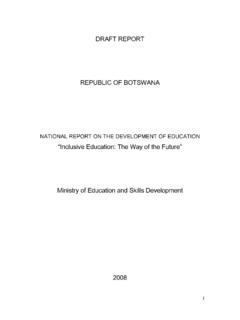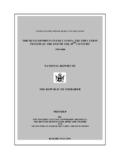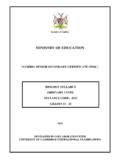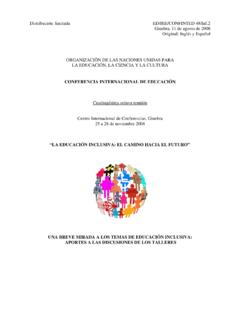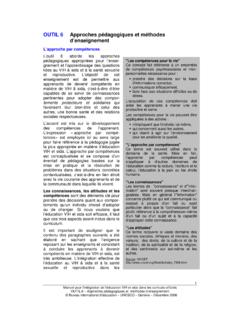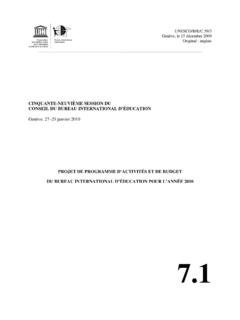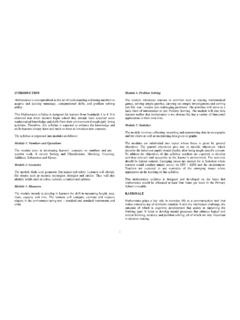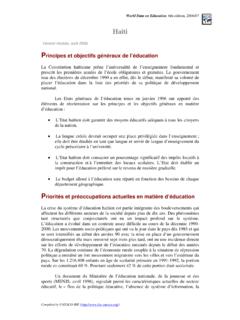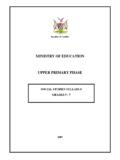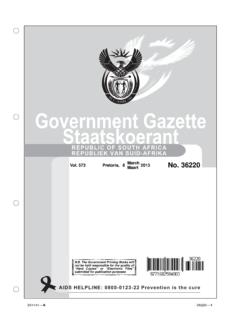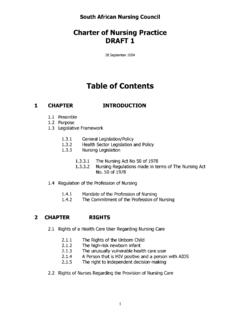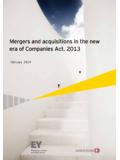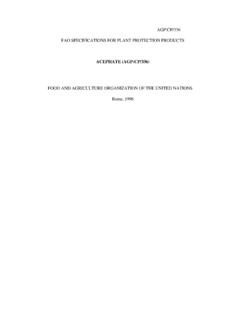Transcription of Policy Revised National Curriculum Statement …
1 Policy Revised National Curriculum Statement Grades R-9. (Schools). Overview Published by the Department of Education Sol Plaatje House 123 Schoeman Street Pretoria Private Bag X895. Pretoria Tel: +27 (12) 312 5911. Fax: +27 (12) 321 6770. Website: Copyright The Department of Education of South Africa Copies of this publication can be obtained from the Directorate: National and Provincial Communication, Department of Education, Pretoria. Tel: (012) 312 5410. ISBN 1-919917-08-X. Gazette No.: 23406, Vol. 443, May 2002. This document must be read as part of the Revised National Curriculum Statement Grades R-9 (Schools). This Revised National Curriculum Statement Grades R-9 (Schools). includes: 1. An Overview 2. Eight Learning Area Statements: Languages Mathematics Natural Sciences Social Sciences Arts and Culture Life Orientation Economic and Management Sciences Technology Contents Contents Preface 1.
2 Foreword 2. Background 4. The Constitution, Values, Nation-building and the Curriculum 6. The Kind of Learner that is Envisaged 8. The Kind of Teacher that is Envisaged 9. Structure of the Revised National Curriculum Grades R-9 (Schools) 9. Principles of the Revised National Curriculum Statement 10. Social Justice, a Healthy Environment, Human Rights 10. and Inclusivity Outcomes-based Education 10. A High Level of Skills and Knowledge for All 12. Clarity and Accessibility 12. Progression and Integration 12. Structure and Concepts Used in the Learning Area Statements 13. What is a Learning Outcome? 14. What is an Assessment Standard? 14. How different is an Assessment Standard from a Learning Outcome? 14. Learning Programmes 15. Learning Programmes Per Phase 15. Learning Programme Guidelines 16. Time Allocations 17. Assessment 18. General Education and Training Certificate 19.
3 I Overview Page Learning Areas: Definitions and Outcomes 19. Languages 19. Definition 19. Outcomes 20. Mathematics 21. Definition 21. Outcomes 21. Natural Sciences 22. Definition 22. Outcomes 23. Social Sciences 23. Definition 23. Outcomes 23. Arts and Culture 24. Definition 24. Outcomes 25. Life Orientation 26. Definition 26. Outcomes 26. Economic and Management Sciences 27. Definition 27. Outcomes 27. Technology 28. Definition 28. Outcomes 28. ii Page Overview Preface Preface The development of a National Curriculum is a major challenge for any nation. At its broadest level, our education system and its Curriculum express our idea of ourselves as a society and our vision as to how we see the new form of socie- ty being realised through our children and learners. Through its selection of what is to be in the Curriculum , it represents our priorities and assumptions of what constitutes a good education' at its deepest level.
4 This Curriculum is written by South Africans for South Africans who hold dear the principles and practices of democracy. It encapsulates our vision of teachers and learners who are knowledgeable and multi-faceted, sensitive to environ- mental issues and able to respond to and act upon the many challenges that will still confront South Africa in this twenty first century. But we must also be realistic about what a Curriculum can and cannot achieve. Inequality and poverty still plague the educational experience of too many fam- ilies and their children. The Curriculum is and will be differently interpreted and enacted in diverse contexts. We will improve and implement it to the best of our ability. We will also make the most strenuous efforts to enable the realisation of its vision through addressing all those issues which make up teaching and learn- ing.
5 This requires the commitment and participation of all who work in education. We need the full cooperation of the Government, parents, teachers, learners and the community at large. I trust this Revised National Curriculum Statement will embody the ideals which will promote such cooperation. PROFESSOR KADER ASMAL, MP. MINISTER OF EDUCATION. 1. Overview Page Foreword Foreword At its special meeting of 12 September 1997, the Heads of Education Departments Committee recommended the Draft Statement of the National Curriculum for Grades R-9 for Ministerial approval. It was referred to and approved by the Council of Education Ministers at its meeting of 29 September 1997 as three separate Policy documents for the Foundation Phase, the Intermediate Phase and the Senior Phase. At its meeting in June 2000, the Council of Education Ministers agreed that the Statement of the National Curriculum for Grades R-9 should be Revised in accordance with the recommendations of the Report of the Review Committee (31 May 2000) to streamline and strengthen Curriculum 2005.
6 A Ministerial Project Committee to Streamline and Strengthen Curriculum 2005. was subsequently established for the task. The process of revision was begun in January 2001 with approximately 150 Curriculum developers drawn from the educational community. On 30 July 2001, the Draft Revised National Curriculum Statement for Grades R-9 (Schools) was released for public comment for a period of three months. In November, public hearings were held on the Curriculum . Once the public comment and contributions at the public hearings were received and analysed, the Curriculum working groups of the Ministerial Project Committee were reconvened in December 2001 to incorporate suggested changes for improvement. The Revised National Curriculum Statement is the result of that process. This document and the eight Learning Area Statements published as Addenda constitute the Revised National Curriculum Statement Grades R-9 (Schools).
7 The Revised National Curriculum Statement Grades R-9 (Schools) will replace the Statement of the National Curriculum for Grades R-9 approved in 1997 once it is introduced into the system. A comprehensive and participatory implementation strategy and plan will be developed with all relevant social partners to ensure the successful introduction of the Revised National Curriculum Statement grade R-9 (Schools). The current Assessment Policy of 23 December 1998 (Government Gazette No 19640) and the Language-in-Education Policy of 14 July 1997 (Government Gazette No 17997) need to be read in conjunction with the Revised National Curriculum Statement Grades R-9 (Schools). The Assessment Policy also needs 2. Page Overview to be read alongside the relevant section of each Learning Area Statement . Until 2008, the Policy currently related to certification will prevail.
8 Thereafter the General Education and Training Certificate aligned to this Revised National Curriculum Statement will come into force. The General Education and Training Certificate for compulsory schooling is a whole qualification for schools based on the extent to which the learning outcomes are achieved through the grade 9 assessment standards. DIRECTOR-GENERAL. THAMI MSELEKU. 3. Overview Page Background Background South Africa's democratic government inherited a divided and unequal system of education. Under apartheid, South Africa had nineteen different educational departments separated by race, geography and ideology. This education system prepared children in different ways for the positions they were expected to occupy in social, economic and political life under apartheid. In each department, the Curriculum played a powerful role in reinforcing inequality.
9 What, how and whether children were taught differed according to the roles they were expected to play in the wider society. Curriculum change in post-apartheid South Africa started immediately after the election in 1994 when the National Education and Training Forum began a process of syllabus revision and subject rationalisation. The purpose of this process was mainly to lay the foundations for a single National core syllabus. In addition to the rationalisation and consolidation of existing syllabi, the National Education and Training Forum Curriculum developers removed overtly racist and other insensitive language from existing syllabi. For the first time Curriculum decisions were made in a participatory and representative manner. But this process was not, nor did it intend to be, a Curriculum development process. The Lifelong Learning through a National Curriculum Framework document (1996).
10 Was the first major Curriculum Statement of a democratic South Africa. It was informed by principles derived from the White Paper on Education and Training (1995), the South African Qualifications Act (No 58 of 1995) and the National Education Policy Act (No 27 of 1996). In terms of the White Paper, it emphasised the need for major changes in education and training in South Africa in order to normalise and transform teaching and learning in South Africa. It also stressed the need for a shift from the traditional aims-and-objectives approach to out- comes-based education. It promoted a vision of: A prosperous, truly united, democratic and internationally competitive coun- try with literate, creative and critical citizens leading productive, self-fulfilled lives in a country free of violence, discrimination and prejudice. The National Education Policy Act (No 27 of 1996) provided for the development of the following Curriculum design tools to support an outcomes- based approach: Critical Cross-Field Outcomes (later to be known as the critical and developmental outcomes, and first formulated in the South African Qualifications Authority Act of 1995).
